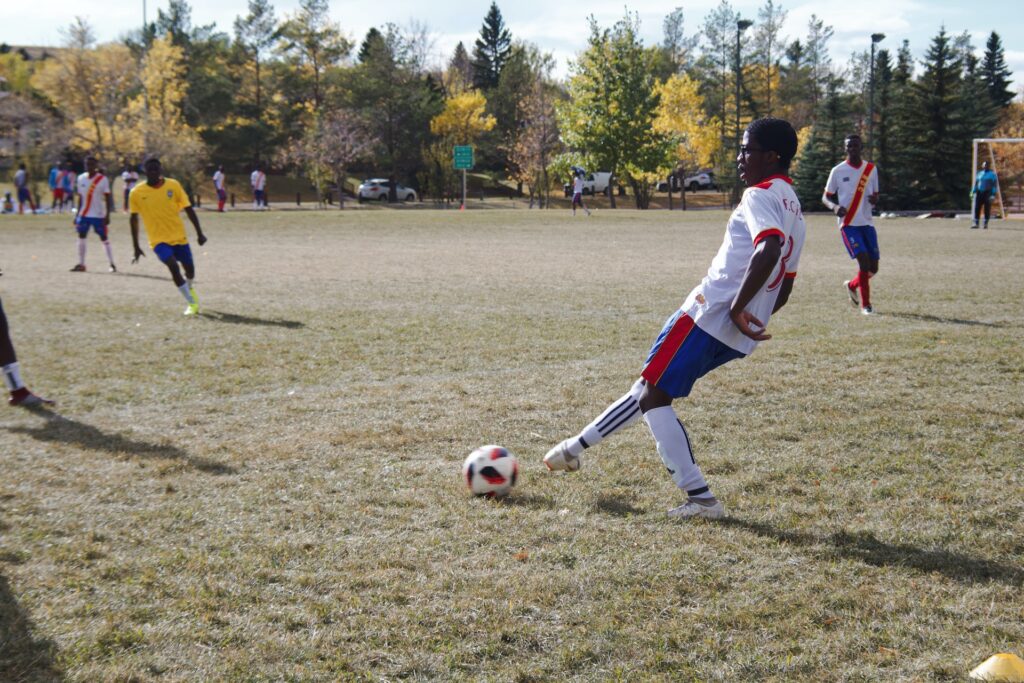Table of Contents
- So, what is a through ball in soccer?
- Why are through balls in soccer important?
- The benefits of through balls in soccer
- Which player is responsible for through balls?
- Five tips for effective through balls in soccer
- Recap: Through balls in soccer
The through ball in soccer – an art form or an absolute essential?!
There are so many types of passes to deliver in soccer. Long balls, a sidewards pass, a cross… they’re all unique but serve the same purpose of getting the ball to a recipient.
Despite the journey it takes, a through ball is no different, but how do we define a through ball?
Let’s examine what a through ball is and who’s best at performing them before we suggest some tips to produce them optimally.
So, what is a through ball in soccer?
A through ball is a pass that is played by splitting at least two opposing defenders in an effort to penetrate a gap and advance into a more threatening position.
The use of the word “through” is accurate because it explains how the pass slices two opposing players. Occasionally you might hear people referring to it as a “through pass,” but they mean the same thing.
Usually, through balls are played along or low to the ground. Aerial balls aren’t really considered through balls because they go over defenders, not necessarily between defenders.
Teammates who have moved, or are moving, beyond the players who the ball is played between look to receive the ball typically further up the field.
Why are through balls in soccer important?
Through balls cause confusion among defensive ranks. As a defender, it’s easy to read the game when it’s being played in front of you. However, once the ball is in behind you and your teammates, things aren’t as simple.
Players further down the field rely on balls played through defenders because you’re far less likely to create any meaningful attacks when the passing is merely sideways between deeper-lying players.
Attackers will look to expose whatever space is behind the defensive lines, and through balls are a surefire way of doing so.
Defensive or midfield units are often organized into lines for positional shape. When a pass breaks the line of an opponent, it cuts through their setup to disorganize them and leave your more forward-thinking players with fewer players to face.
The benefits of through balls in soccer

- Usually, the defender will be facing you if you’re looking to play a through ball, so this type of pass puts them on the back foot once the ball is in behind them, making their job much more difficult.
- Because the ball is played between defenders, it’s not always easy to identify who exactly is responsible for handling the through ball. One defender might feel that their partner should bear the responsibility and vice versa, leading to confusion and errors.
- Frequently defenders will drop deeper to negate fast attackers and prevent long balls, meaning you require neat, incisive passing. The advantage pacey attackers give you is that they require less room to run into, so by slotting the ball through defenders, those fast forwards latch onto weighted passes with their bursts of movement in threatening positions.
- Through balls can drag defenders out of position if the runners are active and the timing of the pass is good. When defenders are out of position, gaps appear, and panic creeps in, which can be exploited.
- Although modern soccer relies on patience, being direct isn’t always bad. Through balls are a fast and useful way to get the ball forward quickly and catch the opponent on their heels.
Which player is responsible for through balls?
Any player on a soccer field can play a through ball.Players who are often associated with delivering through balls are mostly midfield playmakers. Playmakers dictate the tempo and feed their more attacking teammates with clever and incisive passing.
A contemporary example of this is Manchester City midfielder Kevin de Bruyne, arguably the best playmaker on the planet.
His vision to spot the runners is unrivaled, and his execution is almost always inch-perfect.The role of playmaker isn’t exclusive to midfielders, however. Tottenham Hotspur striker Harry Kane is one of the best through ball players in the Premier League, ranking consistently near the top of the charts for such passes every season.
The term ‘quarterbacking’ has crept into the soccer lexicon recently, and for good reason when you see how Kane operates. He drops deep and plays exquisite through balls to willing runners such as teammates Son, Kulusevski, and Richarlison.
Five tips for effective through balls in soccer
- Subtlety is key: If the opposing defenders know that you’re looking to play a through ball, they will narrow your angles and windows to penetrate. Feigning a pass to another player elsewhere can fool the defender into being unprepared for the eventual through ball you play.
- Take a risk: Playmakers are risk-takers. In advanced areas of the field, you can afford to take more risks than players in defensive thirds. As long as the moment is right and your manager hasn’t instructed you otherwise, try to create a chance with a through ball, it’s not the end of the world if it doesn’t work in the attacking third.
- Don’t second guess yourself: Doubting your own ability is a massive obstacle for creators. Trust that you can play the through ball that you envisage, and it’ll make it all the easier.
- Build relationships: On the training ground, linking up with attackers can develop intuition between the two of you. Knowing when the attacker will run and the likely path they’ll take means you know when to play the ball and where to aim for.
- Pick your spot: This might only be possible at a glance if you’re getting harassed by an opposition player, but locating the best area to slot the ball into gives you the best chance of playing a successful through ball.
Recap: Through balls in soccer
Through balls are a very effective way of advancing up the field by breaking the lines of the opposition. Your side can become difficult to maintain if your through balls are accurate and the runners anticipate them well.
Learn to incorporate through balls into your repertoire so that you become even more of a threat going forward, thus boosting your team’s chances of scoring.

